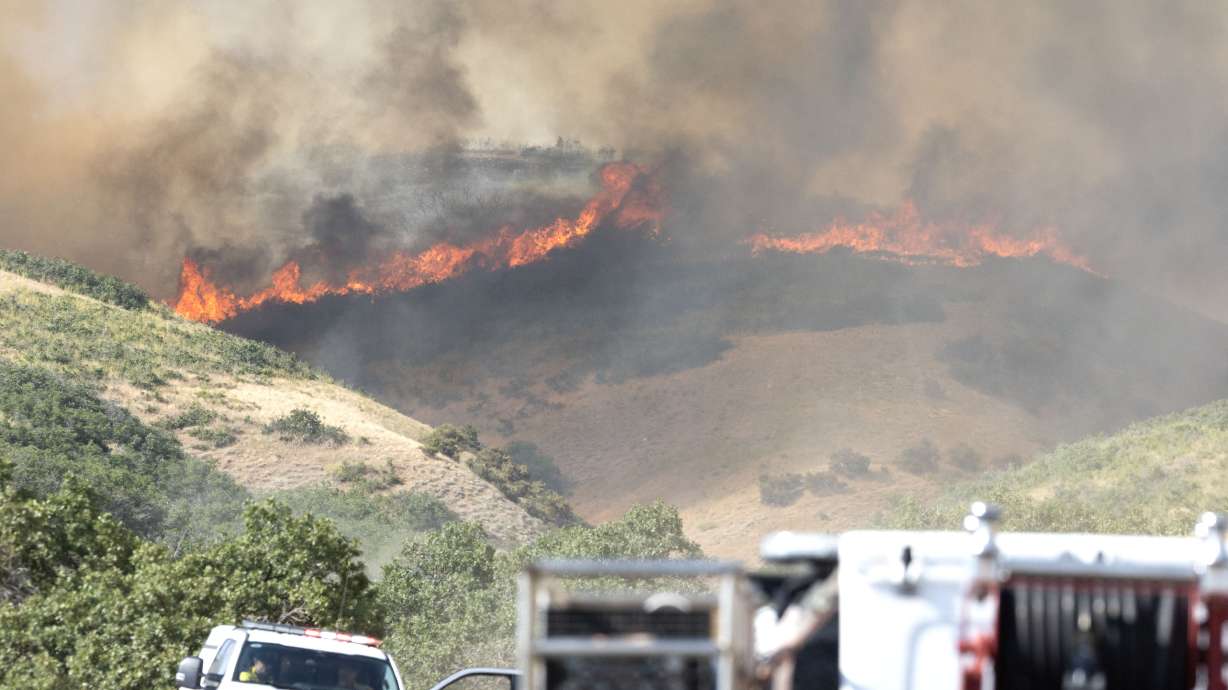Estimated read time: 5-6 minutes
- Experts urge residents to prepare for wildfires during National Wildfire Awareness Month.
- Utah's recent rain and snow have kept fire risk "normal," but experts say it could increase in the coming weeks.
- Fire risk could be above-normal during the first half of summer, but monsoons could help reduce risks later in the season.
SALT LAKE CITY — A storm that dumped rain and snow across Utah over the past few days has been beneficial for the drought-heavy state.
As of noon, several communities had already received over 0.5 inches since Sunday. Alpine, Cedar City, Richfield, Santaquin, and Enterprise, in Washington County, all received over an inch of rain, while nearly 2 inches had dumped in Cove Fort, in Cache County. The storm also overperformed in the mountains, delivering several inches of snow in the upper Cottonwood canyons.
While that's great for current wildfire conditions, things can change fairly quickly, warns Taiga Rohrer, deputy state fire management officer of the Utah Division of Forestry, Fire and State Lands.
"It takes very little time for those fuels to dry out," he said, pointing to invasive cheatgrass as an example of where conditions can change in days.
That's why he and other experts are advising residents to take steps now to prevent wildfires and their potential impacts, instead of waiting until fire conditions worsen. May is National Wildfire Awareness Month, and Rocky Mountain Power recognized the designation Tuesday by bringing in state and local experts to discuss wildfire preparedness and this summer's unique fire outlook.
Utah's fire forecast
Nearly three-quarters of the state remained in drought to start this month, including almost half in severe or extreme drought categories, according to the U.S. Drought Monitor. Despite Utah's drought situation, "normal" fire potential is expected to remain in place throughout the state this month, according to the wildland fire potential outlook that the National Interagency Fire Center's Predictive Services updated last week.
The report states that early May precipitation is helping to keep conditions "moderate," but expected "prolonged" dry periods and winds can pose "brief localized wildfire risk" over the next few weeks. Forecasters wrote that wildfire fuels in southern Utah "will dry quickly by late May and June" unless this month's storms produce precipitation that is "well above normal."
So far, so good on that front.
Although temperatures are forecast to reach the upper 80s along the Wasatch Front by the end of this week, long-range outlooks favor cooler and wetter weather returning by about mid-May. But all it takes is a shift to "continually hot, dry, windy weather" for conditions to worsen, Rohrer cautioned, which is what long-range models currently project could begin by the start of meteorological summer.
Above-average fire potential is projected to return to southern Utah by June and potentially last through July across south-central Utah, but the region's fortunes could change sometime during the month.

Utah has some of the highest probabilities for above-normal temperatures this summer, but central and southern regions are listed as having "equal chances" when it comes to precipitation, according to preliminary meteorological summer outlooks released by the National Weather Service's Climate Prediction Center.
The latter means that there's no clear signal yet whether conditions will be wetter, drier or near-normal between June 1 and Aug. 31. Slightly higher odds for drier-than-normal conditions are expected across northern Utah.
Longer-range models indicate stronger monsoon odds toward the end of summer, which could reach all parts of the state. Based on that probability, all of Utah is listed as returning to "normal" wildfire potential by the end of meteorological summer.
However, experts point out that these are still probabilities, so Utahns should prepare for any situation. They add that normal fire conditions can be burdensome for firefighters.
"A normal fire season is still normally very active," Rohrer said. "Fires can still occur."
What you can do to prepare
The best way to prepare for wildfire season is to create a defensible space outside of your home, state officials say. Clearing leaves and other debris off roofs and gutters and taking other home improvement steps to prevent embers from catching on fire is also important, as embers can engulf a home even if flames don't reach your front door.
As for new fire starts, Utah Fire Sense has plenty of tips. These include:
- Properly douse campfires so they're cold to the touch before you leave a campsite.
- Avoid driving over dry vegetation and prevent any chains from dragging.
- Don't place shooting targets next to or in front of rock backstops or near dry vegetation.
Meanwhile, power companies are also taking steps, especially as power-related fire starts have led to some of the largest fires in the West in recent memory. Some lawsuits claim that downed lines could have started some of California's devastating wildfires earlier this year.
Rocky Mountain Power has a three-member meteorology team that analyzes hundreds of weather stations and active vegetation conditions within its service area, offering daily outlooks for crews to prepare for any given day. The team also uses a program to project how active wildfires will move, helping prepare for potential utility impacts.

Red flag conditions, in which strong winds mixed with low relative humidity and hot temperatures, can prompt the company to take proactive measures, said Allen Berreth, vice president of operations for Utah's largest power provider.
These include using "enhanced safety settings" to "deenergize" power lines when there's any indication that weather or other factors could create problems. The company might also shut off power lines when red flag conditions emerge during a dry period or if wildfire models project that flames are headed to power equipment.
It reduces fire risk, but it could also lead to more power outages.
"We don't take that decision lightly," Berreth said.
Rocky Mountain Power officials say they plan to reach out to customers more directly when these decisions are made, so they recommend that they update their contact information. They add that people should have an emergency plan and an emergency kit in case of a wildfire.









